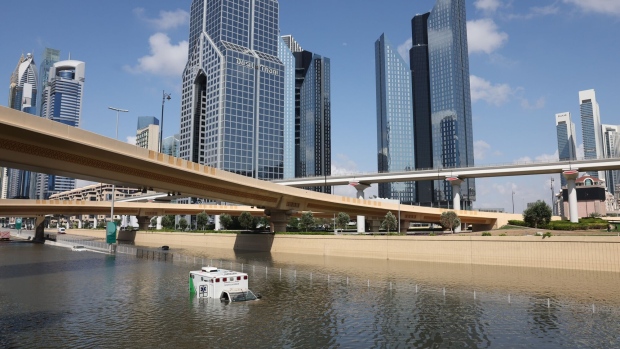Market News
Dubai Floods Expose Weaknesses to a Rapidly Changing Climate - BLOOMBERG
BY , Bloomberg News

An ambulance abandoned in floodwater in Dubai. Photographer: Christopher Pike/Bloomberg , Bloomberg
(Bloomberg) -- The heavy rains that flooded Dubai this week halted air traffic, damaged buildings and streets — and left climate experts and common citizens asking whether one of the world’s hottest and driest cities should be better prepared for extreme storms.
Weather forecasters knew days in advance that a major storm was heading for the United Arab Emirates and authorities issued warnings asking citizens to stay home. Yet its largest city Dubai was still brought to a halt this week, with one of the worst rain events in decades flooding streets, homes and highways.
“Stormwater management systems were historically deemed an ‘unnecessary cost’ due to the limited rainfall” in the UAE, said Karim Elgendy, an associate fellow at the Environment and Society Centre at Chatham House. “As the variability of rainfall increases across the region and as the likelihood of such events rises, the economic case for such systems becomes stronger.”
Human-caused climate change is making extreme weather events like heat and rain more intense, frequent and harder to predict. The Middle East is forecast to face higher temperatures and a decline in overall rainfall, according to long-term scientific projections. But these very arid places will also experience storms that drop unprecedented rain, according to researchers. That’s forcing governments to consider whether to adapt to rare but destructive events — and how.
Representatives for the UAE government didn’t immediately reply to a written request for comment.
“It’s a real tradeoff in thinking about the cost and the opportunity costs,” said Linda Shi, an assistant professor specializing in urban climate adaptation at Cornell University in the US. “These events are likely to be erratic and unpredictable.”
The UAE was battered on Tuesday by its heaviest downpour since records began in 1949. Scientists and weather forecasters attribute the storm to a large amount of moisture rising from warming seas to the atmosphere, before falling as rain over to the Arabian Peninsula.
El Niño, the climate phenomenon that makes seas warmer and alters weather patterns globally, may have affected the storm. Climate change can’t be ruled out as a factor, though more detailed studies are needed to establish its exact influence, several climatologists and forecasters told Bloomberg Green.
“While massive floods like this have occurred in the past, the huge scale and intensity of the rainfall that caused it are exactly what we are seeing more of in our warmer world,” said Hannah Cloke, a professor of hydrology at the University of Reading in the UK. “With so much rain falling all at once, even carefully designed drainage systems will struggle to cope.”
The floods drew immediate attention to the UAE’s cloud-seeding program, which involves injecting particles into clouds that can influence rainfall. But it will take “significant data analysis” to ascertain the role, if any, it played in making the rains more extreme, according to Auroop Ganguly, a civil and environmental engineering professor at Northeastern University in Boston. “Often major floods in a city relate to urban drainage and related infrastructures,” he said.
Dubai and the UAE more broadly were unprepared for such a large amount of water falling over such a short period. Drainage systems quickly proved insufficient to absorb the deluge. Underground garages completely flooded, with water flowing into streets, highways and homes.
Tankers were deployed to pump water from streets once the storm passed, but some communities, lakes and local football grounds remained waterlogged days later. The impacts continue to ripple outward. Shelves in some local supermarkets were still empty on Thursday evening. Schools were shut for four days and government employees were asked to work from home where possible. Dubai’s international airport said Friday afternoon it was allowing departures to operate but it was limiting the number of inbound flights for the next 48 hours.
“Cities in arid regions may be especially ill-prepared for heavy rain events because buildings, landscapes and infrastructure have not been designed with drainage capacity as a primary concern,” said Zachary Lamb, an assistant professor in the Department of City and Regional Planning at the University of California at Berkeley in the US. “Climate change is unsettling long-held assumptions about landscape and climate conditions that have informed the design and planning of buildings and cities for generations.”
Dubai is not alone in facing that problem. Last year, a superstorm burst dams in Libya, causing floods that wreaked havoc in the city of Derna and killed at least 5,000 people. Parts of Beijing were also submerged last year after the Chinese capital was battered by the heaviest rainfall in 140 years of weather records. The flooding washed away homes and caused dozens of fatalities.
“Dubai can only prepare for what it sees as being within the range of probability for the future,” said Lisa Dale, a climate adaptation specialist at Columbia University in the US. “Predictions for future weather patterns foundationally rely on past weather patterns, leaving many governments unprepared for climate change impacts that are not historically common.”
--With assistance from Rakteem Katakey, Verity Ratcliffe, Olivia Rudgard and Leen Al-Rashdan.









